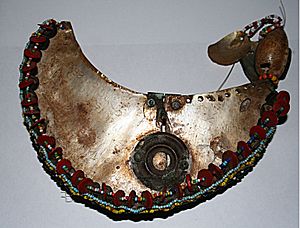Kula facts for kids
Kula is a special way of trading that has been happening for a very long time in the Milne Bay Province of Papua New Guinea. It's more than just trading items; it's about building friendships and showing respect.
Contents
What is the Kula Ring?
The Kula Exchange happens across eighteen islands, including the famous Trobriand Islands. Thousands of people are involved in this unique trading system. Traders travel long distances by canoe, sometimes hundreds of miles, to swap their valuable Kula items.
These special items are:
- Red shell necklaces, called soulava, which travel clockwise around the islands.
- White shell armbands, called mwali, which travel counter-clockwise.
This movement of items in opposite directions creates a big "ring" of trade among the islands. The rules for trading can be a bit different depending on where you are. For example, in some places, you might have to trade a white armband for a necklace. Also, who can join in the Kula trade varies. In the Trobriand Islands, mostly chiefs take part, but in Dobu, anyone can join.
Building Friendships Through Trade
The Kula valuables are not just traded for their looks or material value. They are mainly exchanged to gain social status and respect within the island communities. When people trade Kula items, they become trusted partners. These partnerships can grow into strong, lifelong friendships.
For these relationships to work, both traders need to trust each other. They also agree to support and help each other. It's a system built on mutual respect and strong social connections.
How Kula Trade Works
Kula valuables are usually passed on to new trade partners after a certain amount of time. This means the items are always moving around the Kula Ring. The person who first owned a valuable item has full rights over it. They can choose to keep it, sell it, or even break it.
Because of this, anyone who receives a Kula item doesn't fully own it. There's always an original owner, even if that person is no longer known. This creates a sense of responsibility for how each trader handles the item. Traders are expected to treat the items with care and respect.
Rules of the Kula Exchange
You can't just join the Kula Exchange right away. To take part, a person must first get involved in smaller trade circles. This helps them learn the ropes and build trust before entering the main Kula system.
Kula valuables are judged by how valuable they are and how old they are. The relationships formed through trade are also valued this way. Traders often try to collect famous and valuable Kula objects. This helps improve their reputation and status within the Kula Ring. The Kula Exchange relies on trust, strong social duties, and the community's cultural values. People who hold onto their Kula valuables for too long can get a bad reputation.
Kula and Social Standing
The Kula Exchange system helps decide who has power and influence among the trading islands. For example, in the 1970s, the chiefs on the Trobriand Islands owned the most valuable shells. This meant they were in charge of organizing and guiding most of the trade in their area.
The most important men across all the islands control a large part of the Kula items. With so much control and competition, relationships between traders can sometimes become difficult.
See also
 In Spanish: Kula para niños
In Spanish: Kula para niños


